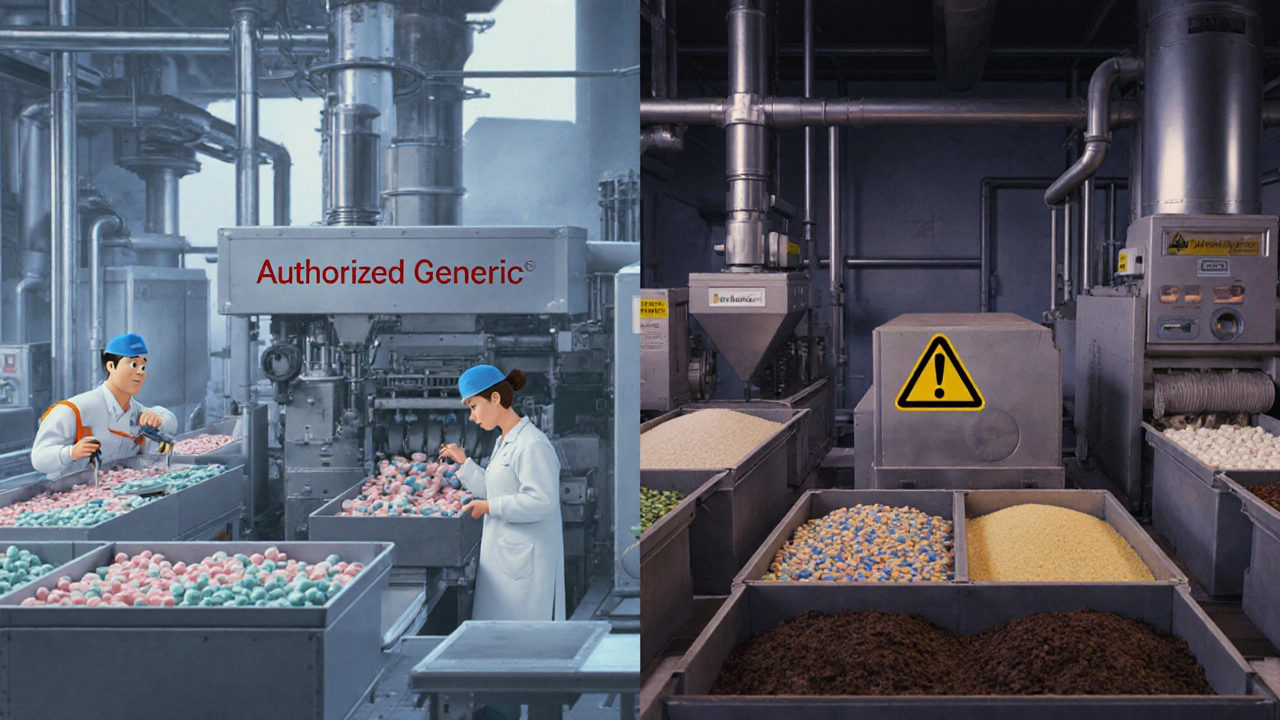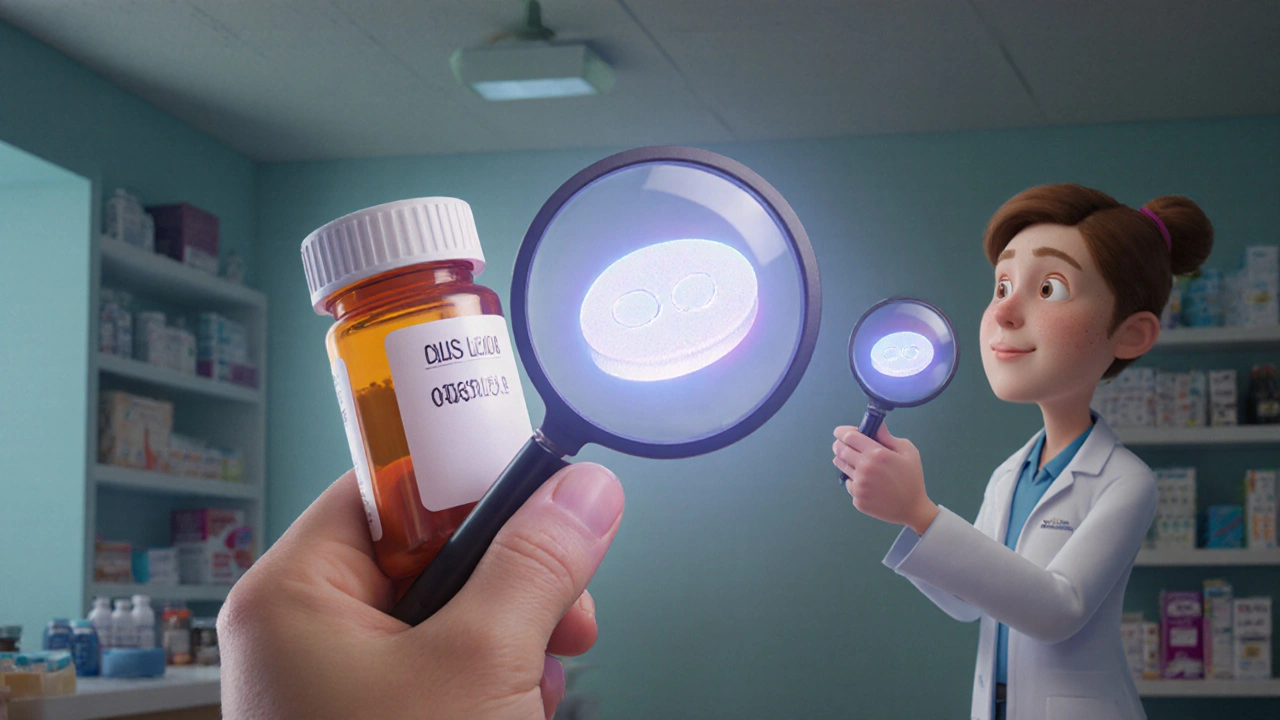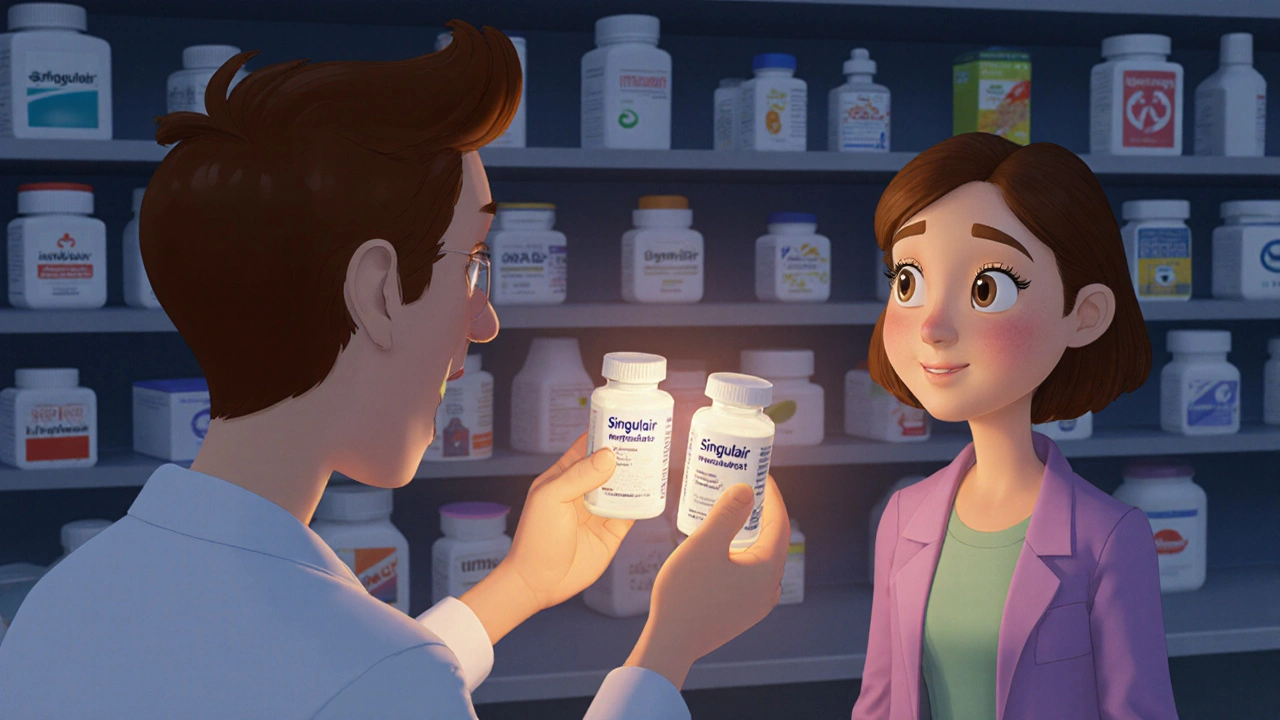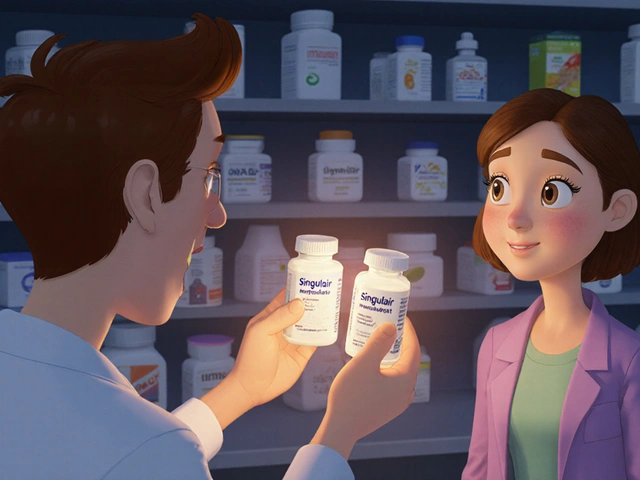When you pick up a prescription, you might see a label that says "generic"-but not all generics are the same. Some are made by the original brand company. Others are made by a different manufacturer. This small difference can matter a lot for how the drug works, what it costs, and even whether your insurance covers it. The two main types are authorized generics and traditional generics. They look similar on the shelf, but behind the scenes, they’re built differently, approved differently, and sometimes even made in the same factory.
What Is an Authorized Generic?
An authorized generic is the exact same drug as the brand-name version, just without the brand name on the bottle. It’s made by the original manufacturer using the same ingredients, same factory, same process. The only difference? The label doesn’t say "Singulair" or "Lipitor." It might say "montelukast" or "atorvastatin" instead.The FDA calls this a "brand-name drug marketed without the brand name on its label." That means if you take an authorized generic of your brand medication, you’re getting the exact same pill-same active ingredient, same inactive ingredients, same shape, same color, same coating. Even the fillers and dyes are identical. The only thing changed is the packaging.
How does this happen? The brand company holds a New Drug Application (NDA) with the FDA. When they decide to launch an authorized generic, they don’t need to submit a new application. They just notify the FDA they’re selling the same drug under a different name. That’s it. No new testing. No new approval. No waiting for patents to expire. In fact, some brand companies launch authorized generics even before the first traditional generic hits the market.
This gives them a way to stay competitive without losing control over quality. If you’ve ever worried that a generic might not work the same way, an authorized generic removes that fear. It’s the brand drug in disguise.
What Is a Traditional Generic?
Traditional generics are made by other companies-not the original brand manufacturer. These companies use the Abbreviated New Drug Application (ANDA) process to get FDA approval. To qualify, they must prove their drug is bioequivalent to the brand-name version. That means it delivers the same amount of active ingredient into your bloodstream at the same rate.But here’s the catch: they don’t have to match the inactive ingredients. That’s right. The active part? Same. The fillers, dyes, binders, and coatings? Can be different. For most people, that doesn’t matter. But for some drugs-especially those with a narrow therapeutic index, like warfarin, levothyroxine, or certain seizure medications-those tiny differences can make a real difference in how the drug works.
Traditional generics are cheaper because the manufacturers don’t have to repeat expensive clinical trials. The FDA already approved the brand drug, so they only need to prove their version behaves the same way in the body. That makes the approval process faster and less costly. But it also means there’s more variation between brands of the same generic drug.
For example, one company’s generic version of metformin might use cornstarch as a binder. Another might use potato starch. Neither is dangerous. But if you’re sensitive to certain fillers-or if the formulation affects how quickly the drug dissolves-your body might react differently. That’s why some patients report feeling different when switching between generic brands.
Key Differences at a Glance
| Feature | Authorized Generic | Traditional Generic |
|---|---|---|
| Manufacturer | Same as brand-name drug | Different company |
| Active Ingredients | Identical to brand | Identical to brand |
| Inactive Ingredients | Identical to brand | May differ |
| Approval Process | Under brand’s NDA; no FDA review needed | ANDA; requires bioequivalence testing |
| Appears in FDA Orange Book? | No | Yes |
| Can enter market before patent expires? | Yes | No |
| Therapeutic Equivalence | Identical to brand | Bioequivalent (FDA-approved) |
| Typical Cost | Lower than brand, often higher than traditional generic | Lowest cost option |

Why Does This Matter to You?
If you’re on a medication where consistency matters-like thyroid medicine, blood thinners, or asthma inhalers-knowing which kind of generic you’re getting can help avoid unexpected side effects or changes in how you feel.Some patients report that switching from a brand to a traditional generic caused them to feel "off." Their symptoms returned. Their energy dropped. Their blood pressure fluctuated. Often, switching back to the brand-or to the authorized generic-fixed the problem. That’s not in their head. It’s because the inactive ingredients changed how the drug was absorbed.
Authorized generics eliminate that risk. Since they’re made by the same company, with the same formula, you get the same experience as the brand-just at a lower price. That’s why many doctors and pharmacists recommend them for sensitive medications.
But here’s the catch: you won’t know you’re getting an authorized generic unless you ask. They’re not listed in the FDA’s Orange Book, which is what most pharmacies use to check equivalence. So even your pharmacist might not know unless they check the manufacturer’s name on the bottle.
How to Tell Which One You’re Getting
The easiest way is to look at the manufacturer name on the label. If it’s the same company that makes the brand-name drug-like Merck, Pfizer, or AstraZeneca-then you’re likely getting an authorized generic.For example:
- Brand: Singulair (montelukast) by Merck
- Authorized generic: Montelukast by Merck
- Traditional generic: Montelukast by Teva, Mylan, or Apotex
Some pharmacies will note on the receipt or label if it’s an authorized generic. But most won’t. So if you’re unsure, ask your pharmacist: "Is this the same as the brand?" or "Is this made by the original company?"
Another trick: check the pill’s imprint code. Authorized generics often have the same imprint (letters/numbers on the pill) as the brand. Traditional generics might have a different shape or color, even if the active ingredient is the same.
Insurance and Cost: What You’ll Pay
Authorized generics usually cost less than the brand name, but sometimes more than traditional generics. That’s because they’re still made by the brand company, which has higher overhead. Traditional generics, made by companies competing for the lowest bid, often win on price.Insurance companies prefer traditional generics because they’re cheaper. But many plans now cover authorized generics at the same tier as traditional generics-especially for drugs where consistency matters. Some even list them as preferred options.
If your insurance denies coverage for the brand but covers the generic, ask if they cover the authorized generic. Sometimes, it’s the best middle ground: lower cost, same quality.

When to Choose One Over the Other
- Choose an authorized generic if: You’ve had issues switching to traditional generics, you’re on a narrow therapeutic index drug, you want maximum consistency, or you’re concerned about inactive ingredients.
- Choose a traditional generic if: You’re on a stable medication like high blood pressure or cholesterol pills, cost is your top priority, and you haven’t noticed any changes after switching.
For most people, traditional generics are perfectly safe and effective. But for a subset of patients-especially those with chronic conditions that require tight control-authorized generics offer peace of mind.
What About Brand Generics?
Don’t confuse authorized generics with "brand generics." That’s a different thing entirely. A brand generic is a traditional generic that’s been given a catchy name-like "Teva’s Amlodipine" or "Mylan’s Metformin." It’s still a traditional generic. It went through the ANDA process. It may have different inactive ingredients. It’s just marketed under a brand-like name. That’s not the same as an authorized generic.Pharmacists sometimes mix these up. So do patients. If you hear "this is a brand generic," ask: "Is it made by the original company?" If the answer is no, it’s not an authorized generic.
Final Thoughts
The generic drug market is more complex than it looks. Just because something says "generic" doesn’t mean it’s the same as every other generic. Authorized generics give you the brand experience without the brand price. Traditional generics give you the lowest price, with a small risk of variability.Know what you’re taking. Ask questions. Don’t assume all generics are equal. If your medication is critical to your health, the difference between identical ingredients and slightly different fillers could be more than just a label change-it could be the difference between feeling well and feeling off.
And if you’re unsure? Talk to your pharmacist. They’re the ones who can tell you exactly what’s in that bottle-and whether it’s the same as the brand.
Are authorized generics safer than traditional generics?
Authorized generics are not inherently safer-they’re just more consistent. Both types meet FDA quality standards. But because authorized generics have the exact same ingredients as the brand, including inactive ones, they reduce the risk of variability in how the drug works. This makes them a better choice for medications where small changes can affect outcomes, like thyroid or seizure drugs.
Can I ask my pharmacist for an authorized generic?
Yes, you can ask. Simply say: "Is there an authorized generic available for this medication?" or "Can you fill this with the version made by the original brand company?" Many pharmacists can check their inventory or contact suppliers to find out. Some pharmacies even have a list of authorized generics on file.
Why aren’t authorized generics listed in the FDA’s Orange Book?
The Orange Book only lists drugs approved through the ANDA process. Authorized generics are sold under the original brand’s NDA, so they don’t go through the ANDA process. That’s why they’re not included. The FDA does maintain a separate, unofficial list of authorized generics, but it’s not as easy to find. Pharmacists often rely on manufacturer info or pharmacy databases instead.
Do authorized generics cost more than traditional generics?
Sometimes, but not always. Authorized generics usually cost less than the brand name but can be slightly more expensive than traditional generics because they’re made by the original manufacturer. However, since they’re often priced aggressively to compete with traditional generics, the difference is usually small-sometimes just a few dollars per prescription.
Can a doctor prescribe an authorized generic specifically?
Doctors can’t prescribe an authorized generic by name because it doesn’t have a separate FDA-approved name. They prescribe the generic name (e.g., "montelukast"). But they can write "DAW" (dispense as written) or "do not substitute" if they want you to get the brand or authorized generic. If they want you to get the authorized version, they may write the brand name with "or authorized generic" noted on the prescription.
Are authorized generics available for all medications?
No. Authorized generics are mostly available for oral solid drugs like pills and capsules, especially those with high sales volume. They’re less common for injectables, inhalers, or complex formulations. Brand manufacturers decide whether to launch them based on market competition and profit potential. So while hundreds of authorized generics exist, they don’t cover the full range of generic medications.


